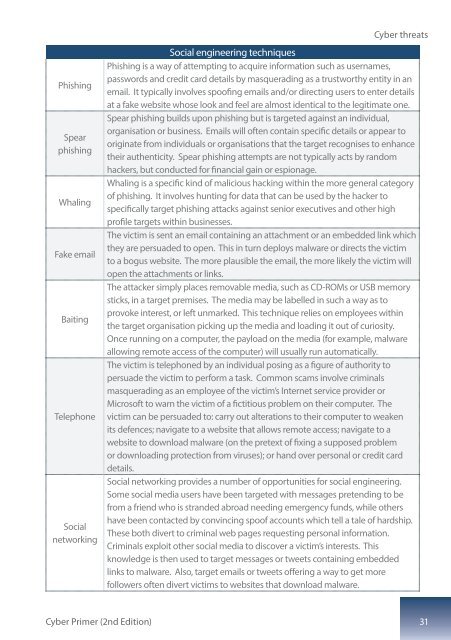Cyber Primer
AEWhbF
AEWhbF
Create successful ePaper yourself
Turn your PDF publications into a flip-book with our unique Google optimized e-Paper software.
Phishing<br />
Spear<br />
phishing<br />
Whaling<br />
Fake email<br />
Baiting<br />
Telephone<br />
Social<br />
networking<br />
<strong>Cyber</strong> threats<br />
Social engineering techniques<br />
Phishing is a way of attempting to acquire information such as usernames,<br />
passwords and credit card details by masquerading as a trustworthy entity in an<br />
email. It typically involves spoofing emails and/or directing users to enter details<br />
at a fake website whose look and feel are almost identical to the legitimate one.<br />
Spear phishing builds upon phishing but is targeted against an individual,<br />
organisation or business. Emails will often contain specific details or appear to<br />
originate from individuals or organisations that the target recognises to enhance<br />
their authenticity. Spear phishing attempts are not typically acts by random<br />
hackers, but conducted for financial gain or espionage.<br />
Whaling is a specific kind of malicious hacking within the more general category<br />
of phishing. It involves hunting for data that can be used by the hacker to<br />
specifically target phishing attacks against senior executives and other high<br />
profile targets within businesses.<br />
The victim is sent an email containing an attachment or an embedded link which<br />
they are persuaded to open. This in turn deploys malware or directs the victim<br />
to a bogus website. The more plausible the email, the more likely the victim will<br />
open the attachments or links.<br />
The attacker simply places removable media, such as CD-ROMs or USB memory<br />
sticks, in a target premises. The media may be labelled in such a way as to<br />
provoke interest, or left unmarked. This technique relies on employees within<br />
the target organisation picking up the media and loading it out of curiosity.<br />
Once running on a computer, the payload on the media (for example, malware<br />
allowing remote access of the computer) will usually run automatically.<br />
The victim is telephoned by an individual posing as a figure of authority to<br />
persuade the victim to perform a task. Common scams involve criminals<br />
masquerading as an employee of the victim’s Internet service provider or<br />
Microsoft to warn the victim of a fictitious problem on their computer. The<br />
victim can be persuaded to: carry out alterations to their computer to weaken<br />
its defences; navigate to a website that allows remote access; navigate to a<br />
website to download malware (on the pretext of fixing a supposed problem<br />
or downloading protection from viruses); or hand over personal or credit card<br />
details.<br />
Social networking provides a number of opportunities for social engineering.<br />
Some social media users have been targeted with messages pretending to be<br />
from a friend who is stranded abroad needing emergency funds, while others<br />
have been contacted by convincing spoof accounts which tell a tale of hardship.<br />
These both divert to criminal web pages requesting personal information.<br />
Criminals exploit other social media to discover a victim’s interests. This<br />
knowledge is then used to target messages or tweets containing embedded<br />
links to malware. Also, target emails or tweets offering a way to get more<br />
followers often divert victims to websites that download malware.<br />
<strong>Cyber</strong> <strong>Primer</strong> (2nd Edition) 31


